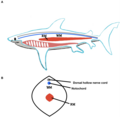Portal:Sharks
Welcome to the shark portal

Sharks are a group of elasmobranch fish characterized by a cartilaginous skeleton, five to seven gill slits on the sides of the head, and pectoral fins that are not fused to the head. Modern sharks are classified within the clade Selachimorpha (or Selachii) and are the sister group to the Batoidea (rays and kin). Some sources extend the term "shark" as an informal category including extinct members of Chondrichthyes (cartilaginous fish) with a shark-like morphology, such as hybodonts. Shark-like chondrichthyans such as Cladoselache and Doliodus first appeared in the Devonian Period (419–359 Ma), though some fossilized chondrichthyan-like scales are as old as the Late Ordovician (458–444 Ma). The oldest modern sharks (selachians) are known from the Early Jurassic, about 200 Ma.
Sharks range in size from the small dwarf lanternshark (Etmopterus perryi), a deep sea species that is only 17 centimetres (6.7 in) in length, to the whale shark (Rhincodon typus), the largest fish in the world, which reaches approximately 12 metres (40 ft) in length. They are found in all seas and are common to depths up to 2,000 metres (6,600 ft). They generally do not live in freshwater, although there are a few known exceptions, such as the bull shark and the river shark, which can be found in both seawater and freshwater. Sharks have a covering of dermal denticles that protects their skin from damage and parasites in addition to improving their fluid dynamics. They have numerous sets of replaceable teeth.
Several species are apex predators, which are organisms that are at the top of their food chain. Select examples include the tiger shark, blue shark, great white shark, mako shark, thresher shark, and hammerhead shark. (Full article...)
Selected article -
This aggressive but slow-moving fish dominates feeding frenzies, and is a danger to survivors of oceanic shipwrecks and downed aircraft — it has attacked more humans than all other shark species combined. Recent studies have shown that its numbers are in steep decline as its large fins are highly valued as the chief ingredient of shark fin soup and, as with other shark species, the oceanic whitetip faces mounting pressure from fishing throughout its range.
Did you know (auto-generated)

- ... that the greeneye spurdog, Sydney skate, grey skate and whitefin swellshark are at risk of extinction by trawling, according to a 2021 report?
- ... that since 2018, IKEA's stuffed toy shark Blåhaj has become a popular Internet meme and an icon of the online transgender community?
- ... that Timo Meier became the first player in San Jose Sharks franchise history to score five goals in one game when he was 25?
- ... that Hixxy and Sharkey created a schism in the UK rave music scene in 1995?
- ... that the ampullae of Lorenzini enable sharks to sense electric fields?
- ... that Alexis Sharkey's last Instagram post before her murder documented her travels to Tulum, Mexico?
Categories
Related portals
WikiProjects
Selected picture -

More Did you know? -
- ... that the milk shark is so named because of a belief in India that eating its meat improves lactation?
- ... that the silky shark is the most common source of ornamental shark jaws sold to tourists in the tropics?
- ... that the southern African frilled shark preys mainly on smaller sharks, which it swallows whole with its greatly distensible mouth?
- ... that more than 90 percent of the night sharks caught off northeastern Brazil contain mercury concentrations higher than that considered safe by the local government?
- ... that the largetooth cookiecutter shark has the largest teeth relative to its body of any living shark?
General images
Topics
For additional lists of marine life-related featured articles and good articles see:
- WikiProject Cetaceans § Featured and Good Content
- Portal:Fish/Recognized content
- Portal:Marine life/Recognized content
Wikimedia
The following Wikimedia Foundation sister projects provide more on this subject:
-
Commons
Free media repository -
Wikibooks
Free textbooks and manuals -
Wikidata
Free knowledge base -
Wikinews
Free-content news -
Wikiquote
Collection of quotations -
Wikisource
Free-content library -
Wikispecies
Directory of species -
Wikiversity
Free learning tools -
Wiktionary
Dictionary and thesaurus
Sources
-
List of all portals List of all portals -
WikiProject Portals WikiProject Portals
This page was last updated at 2023-08-23 02:56 UTC. Update now. View original page.
All our content comes from Wikipedia and under the Creative Commons Attribution-ShareAlike License.












































